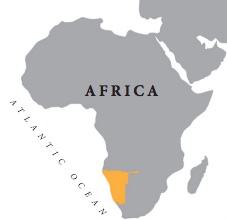Namibia
Namibia is an immense and scenic African nation, twice the size of Texas with ten times fewer people. It is a country of endless horizons and stunning landscapes, from the rugged Skeleton Coast in the West, to the harsh Namib Desert at its center, to the broad floodplains of the Zambezi River in the East.  The people of Namibia are no less stunning, from the Himba and their ochre skin, to the Herero and their colorful cattle, to the many tribes and traditions of the Caprivi. And, of course, there are Namibia’s most famous inhabitants, the elephants. During the dry season, Namibia is home to over 30,000 elephants as well as lion, hippo, rhino, leopard, giraffe, cheetah, buffalo and numerous other species.
The people of Namibia are no less stunning, from the Himba and their ochre skin, to the Herero and their colorful cattle, to the many tribes and traditions of the Caprivi. And, of course, there are Namibia’s most famous inhabitants, the elephants. During the dry season, Namibia is home to over 30,000 elephants as well as lion, hippo, rhino, leopard, giraffe, cheetah, buffalo and numerous other species.
While more than seventy percent of Namibia’s urban population has access to the national electric grid, only 15 percent of rural households are connected, and 93 percent of all households use wood for cooking. It is difficult to provide grid access to everyone in the country because Namibia’s population exists primarily in small, scattered pockets. Namibia’s distances are dauntingly far and it is prohibitively costly and difficult to provide grid access in diverse areas of low population density. While urban and peri-urban areas are being increasingly electrified, rural areas are passed over in the electrification process; in fact, most households are not plotted to get access to grid electricity in the next twenty years, if ever. Unless a solution is found, these people will be forced to rely on fuels such as wood, candles, kerosene, batteries, diesel generators for their energy needs for decades to come. The development of a new solution to Namibia’s rural energy crisis involving distributed sources of solar energy is necessary to meet the needs of its rural populations.
Please click here to learn more about our current projects in Namibia and Zambia.


